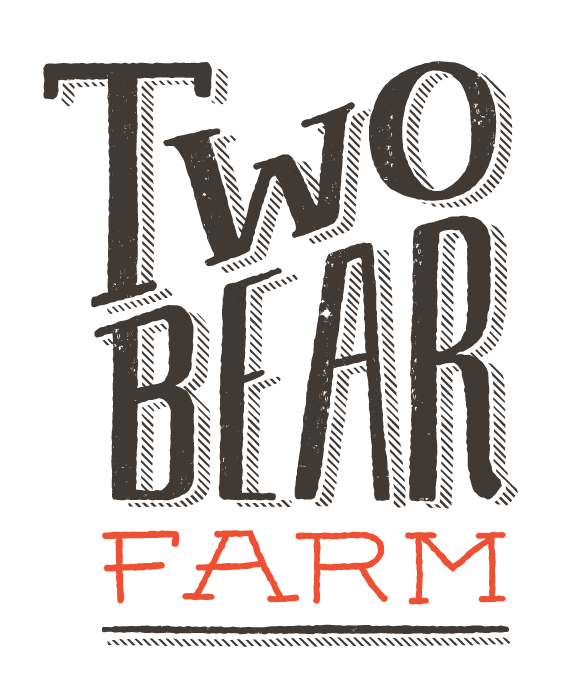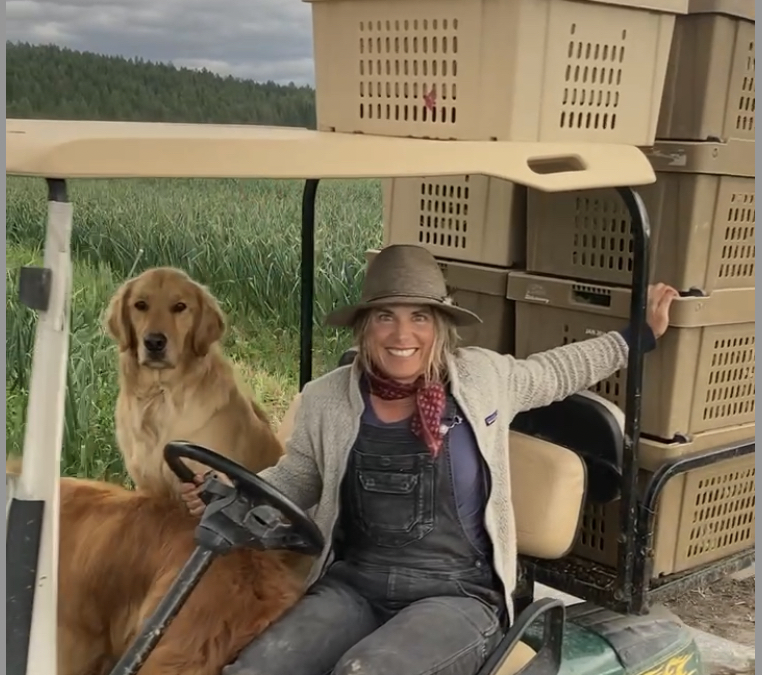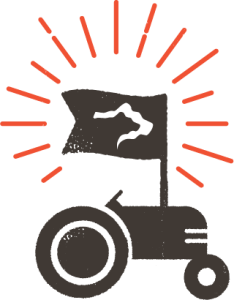Full Share: Salad MIx, Broccolini, Radishes, Broccoli, Spring Onions, Garlic Scapes, and Parsley
Partial Share: Salad Mix, Broccolini, Carrots, Green Cabbage, and Garlic Scapes.
After 6 weeks of often-sweltering spring weather that felt more like summer, Ma Nature is here to remind us this week that it’s still spring with a good old-fashioned cold front. Last night the farm very briefly got down to the freezing mark, and I expect it will be the same tonight and Wednesday. And that folks, is why we don’t grow our tomatoes out in the field.

After a very busy planting season with little time off, I am super excited to be headed to Helmville, MT this weekend for the first Old Salt Festival. It’s a Montana celebration of land stewardship, replete with amazing food, workshops, good music, writing, and probably some booze….all outdoors on the beautiful Mannix Ranch. When I was a fledgling wildlife biologist, I worked on a Canada Lynx project in the mountains that surround the Mannix Ranch, and it is a remote and beautiful place that I think represents the essence of Montana. Helmville doesn’t even have a Chick-fil-A?!
And the reason I eventually transitioned from biologist to being a farmer, in addition to getting to explain to people what a Kohlrabi is, was the idea of using farming as a means to be a land steward and to impact how people interact with the land.
What I love about the concept of this festival is that it is a group of producers deciding to take things into their own hands, to use their creativity, and to reconnect with consumers directly to tell their story. For too long, farmers in this country have been separated from customers by a huge industry of processors, distributors, and retailers that take 92 cents of every food dollar, and leave farmers and ranchers with just 8 cents out of every food dollar to pay for all the hard work and risk they take on. And while this disconnect has been bad for farmers and ranchers, I believe it has been even worse for consumers. I heard recently that the American population is now 85% urban or suburban. And it seems apparent that when people urbanize, they lose touch with what happens on the land, where things come from, and how they are produced. We become consumers, where everything is readily available to those with money, and we become completely dependent on the system for basically all of our needs. While cultivating and growing our own food has been part of humanity for over 10,000 years, in just the last two generations, the vast majority of Americans have lost the knowledge of how to grow food, or to even know where it comes from. The less we know about how food is grown, and the less we are connected to the land , the less we understand how things are changing and how industrialization has completely altered our food supply. Few people realize that most (as in over 90%) of milk, beef, poultry and eggs in the grocery store comes from huge confined feeding operations as opposed to family farms. Few people realize how many ag chemicals are used on food, or the fact that Glyphosate (the main ingredient in Roundup) is so prevalent that it can be found in over 90% of Americans urine ( and breast milk). I’ll stop there, but the list goes on and on.
As people move away from “working landscapes” and lose contact with how things are produced, we become consumers where everything is “out of sight, out of mind”. This is the opposite of being aware. This is a system that enables us to not have to see or pay attention to what is behind all of our consumption. And I believe this type of disconnect is one of the biggest issues we face as humans. When we stop paying attention to the values behind what we consume, and instead focus only on price, it’s becomes one big race to the bottom.
So, I guess my point is, for things to turn around regarding food quality, land management, ecosystem health, and human health statistics in this country (60% of adults with chronic illness?), people need to begin reconnecting with where their food comes from, how it is grown, and why that matters. So much news about climate change, cows, farming, artificial meat, etc. all suffer from a lack of understanding that it’s not the cow, it’s the how. How we grow food matters! And people learning about where food comes from is super important to our collective future. Our CSA is one way to do that. Going to Old Salt Festival is another way to do that. Whatever it takes to get people to become more “informed” consumers while there are still choices to make.
Phew, did I say I could use a weekend off?! I am so ready 🙂
This week the broccoli and broccolini on the farm exploded, so you’ll all be getting a healthy serving of one or both. And the garlic plants are producing scapes for the next few weeks, which you can use just like spring onions. And full shares are getting parsley, which after having an amazing chimmichuri sauce the other night, I suggest you track down a recipe and give it a shot.

Lastly, for the next four Thursdays, we will be hosting volunteer days in cooperation with North Valley Food Bank and Land to Hand Montanan from 9am to noon at the farm. I know those hours are limiting for some folks, but we’ll see how it goes. As a farm, we have committed to growing food for both these organizations this year in exchange for some volunteer days to help us tackle our weeds. If any of you would like to come out to help, and see the farm at a beautiful time of year, please contact kristen@northvalleyfoodbank.org for more info, or simply come out. Long pants and work gloves are required.
Looking forward to seeing you at CSA pickup, and I hope you’re enjoying the cooler weather!
Todd










❤️❤️❤️❤️❤️❤️
I always learn something from your blog. By the way your Grandfather was a lone voice when he spoke about the topics you covered. He was a man before his time. How proud he would be if you. Sharing a wee bit of your pain…a determined black bunny wiped out my peas
…and you think Montana farming is rough….?
Thanks for the continuing education and your hard work. I always appreciate your thoughts and am grateful to be a small part of what you & Rebecca have created for our valley – it makes a big difference & gives me a bit of hope😉
Have a great time at the festival, looking forward to hearing about it.